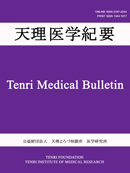Volume 16, Issue 1
Displaying 1-9 of 9 articles from this issue
- |<
- <
- 1
- >
- >|
Foreword
-
2013Volume 16Issue 1 Pages s1
Published: 2013
Released on J-STAGE: December 25, 2013
Download PDF (186K)
Special Article
-
Article type: Special Article
2013Volume 16Issue 1 Pages 1-16
Published: 2013
Released on J-STAGE: July 25, 2013
Download PDF (4957K)
Original Article
-
Article type: Original Article
2013Volume 16Issue 1 Pages 17-24
Published: 2013
Released on J-STAGE: July 25, 2013
Download PDF (754K)
Case Report
-
Article type: Case Report
2013Volume 16Issue 1 Pages 25-30
Published: 2013
Released on J-STAGE: July 25, 2013
Advance online publication: April 18, 2013Download PDF (3860K) -
Article type: Case Report
2013Volume 16Issue 1 Pages 31-39
Published: December 25, 2013
Released on J-STAGE: July 25, 2013
Advance online publication: May 05, 2013Download PDF (4671K) -
Article type: Case Report
2013Volume 16Issue 1 Pages 40-44
Published: 2013
Released on J-STAGE: July 25, 2013
Download PDF (838K)
Pictures at Bedside and Bench
-
Article type: Pictures at Bedside and Bench
2013Volume 16Issue 1 Pages 45-46
Published: 2013
Released on J-STAGE: July 25, 2013
Download PDF (598K) -
Article type: Pictures at Bedside and Bench
2013Volume 16Issue 1 Pages 47-48
Published: 2013
Released on J-STAGE: July 25, 2013
Download PDF (503K)
2012 Symposium
-
Article type: 2012 Symposium
2013Volume 16Issue 1 Pages 49-58
Published: 2013
Released on J-STAGE: July 25, 2013
Download PDF (1068K)
- |<
- <
- 1
- >
- >|
